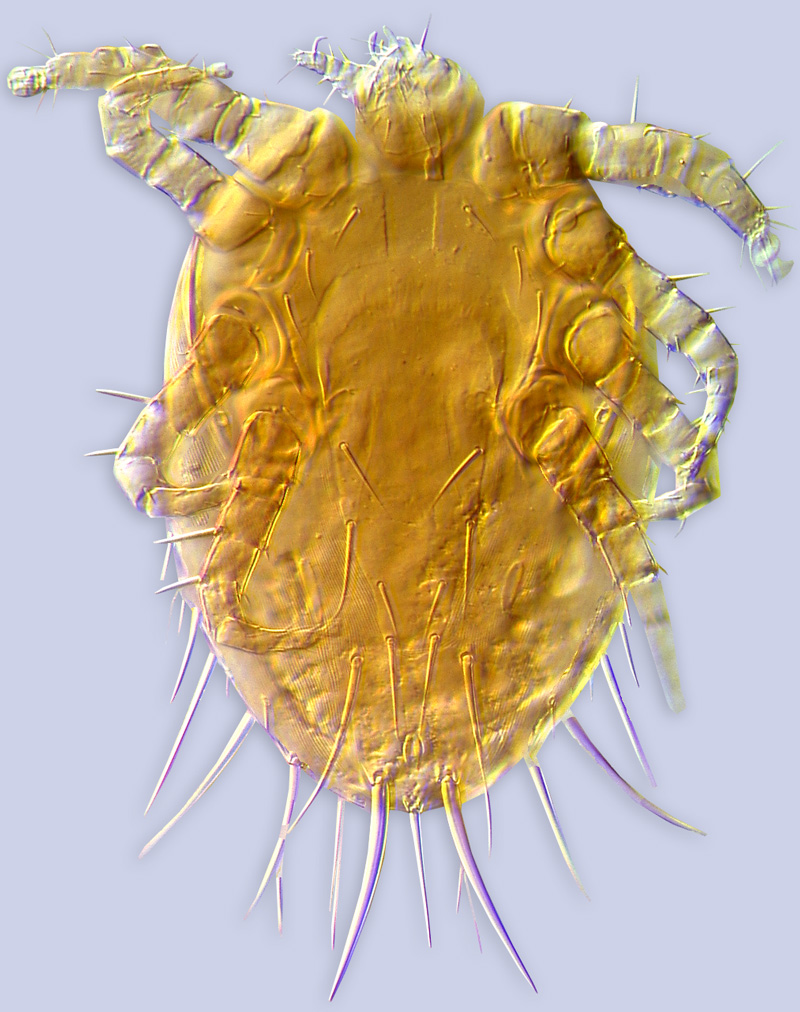Bee Mites : Acari : Parasitiformes : Mesostigmata : Laelapidae
Genus Urozercon Berlese, 1902
Urozercon Berlese, in Berlese and Leonardi, 1902: 13 (type species Urozercon paradoxus Berlese, 1902 by monotypy); Silvestri, 1903: 172; Silvestri, 1911: 70; Silvestri, 1917: 299; Casanueva, 1993: 21.
Termitacarus Trägårdth, 1906: 875 (type species Termitacarus cuneiformis Trägårdth, 1906 by original designation) (synonymized by Silvestri, 1917)
Uronyssus Halliday, 2006: 35 (type species Uronyssus watsoni Halliday, 2006 by original designation), syn. n.
Myrmozercon (non Berlese, 1902): Rosario and Hunter, 1988: 466 (part.).
Type speices Urozercon paradoxus Berlese, 1902 by monotypy
Material (show database records).
General Description. This little-known genus includes eight described species from Australia, South and Central America. Species of Urozercon occur commonly in tropical termite nests and have been observed riding on termites and stealing food during trophallaxis (Silvestri, 1917; Eickwort, 1990). Urozercon paradoxus Berlese, 1902, Urozercon cuneiformis (Trägårdth, 1906), Urozercon modestus Silvestri, 1917, Urozercon robustisetus (Rosario and Hunter, 1988), comb. n. (from Myrmozercon), Urozercon milleri (Halliday, 2006) comb. n. (from Uronyssus), and Urozercon watsoni (Halliday, 2006) comb. n. (from Uronyssus) were found in nests of termites. Several species were described from meliponine and centridine bees normally constructing their nests in termitaria: Urozercon melittophilus Silvestri, 1911 was found on the stingless bee Partamona cupira (Smith, 1863) while Urozercon angustatus Silvestri, 1911, stat. n. (Urozercon melittophilus var. angustatus Silvestri, 1911) was found on Centris thoracica (Hymenoptera: Apidae).
We collected a small series of Urozercon sp. in a nest of Scaura latitarsis (Friese, 1900) constructed inside a termite nest in Costa Rica (first record of Urozercon for North America). Silvestri (1903) reported nests of several species of Meliponini, including S. latitarsis, from nests of the termite Nasutitermes brevioculatus (Holmgren, 1910), the host of the mite Urozercon paradoxus.
Species found in associations with bees
Key to species of the genus Urozercon*
females
|
| 1 | Genu and femur III with stout, needle-like anterior setae |
|
|
- | Genu and femur III without stout, needle-like anterior setae. Unpaired anal seta shorter than paired anal setae. Brazil: Matto Grosso, ex Centris thoracica (Hymenoptera: Apidae) ... Urozercon angustatus
|
|
2(1) | Unpaired anal seta longer or equal to paired anal setae |
|
|
- | Unpaired anal seta shorter than paired anal setae |
|
|
3(2) | Fourth pair of epigynial setae situated on separate platelets outside epigynial shield. Australia: New South Wales, ex Nasutitermes exitiosus ... Urozercon watsoni
|
|
- | Fourth pair of epigynial setae situated on epigynial shield |
|
|
4(3) | Sternal shield concavity exceeding half of maximal length of sternal shield. Anterior ventrianal setae distinctly protruding posterior edge of ventrianal shield. Costa Rica, ex Scaura latitarsis (Apidae: Meliponini) ... Urozercon sp.
|
|
- | Sternal shield concavity distinctly shorter than half of maximal length of sternal shield. Anterior ventrianal setae nearly reaching posterior edge of ventrianal shield. Australia: Northern Territory, ex Nasutitermes graveolus... Urozercon milleri
|
|
5(2) | Unpaired anal seta equal to paired anal setae. Brazil: Matto Grosso, ex Partamona cupira (Apidae: Meliponini) ... Urozercon melittophilus
|
|
- | Unpaired anal seta distinctly longer than paired anal setae. Brazil: Mato Grosso ("Cingalá" in the original description), ex Nasutitermes brevioculatus (Isoptera: Termitidae) ... Urozercon paradoxus
|
* Urozercon robustisetus (Puero Rico, termite nest) is known from male and not included to the key.
References
Image Gallery
B. OConnor and P. Klimov ©
Created: April 23, 2012
Last modified: 

